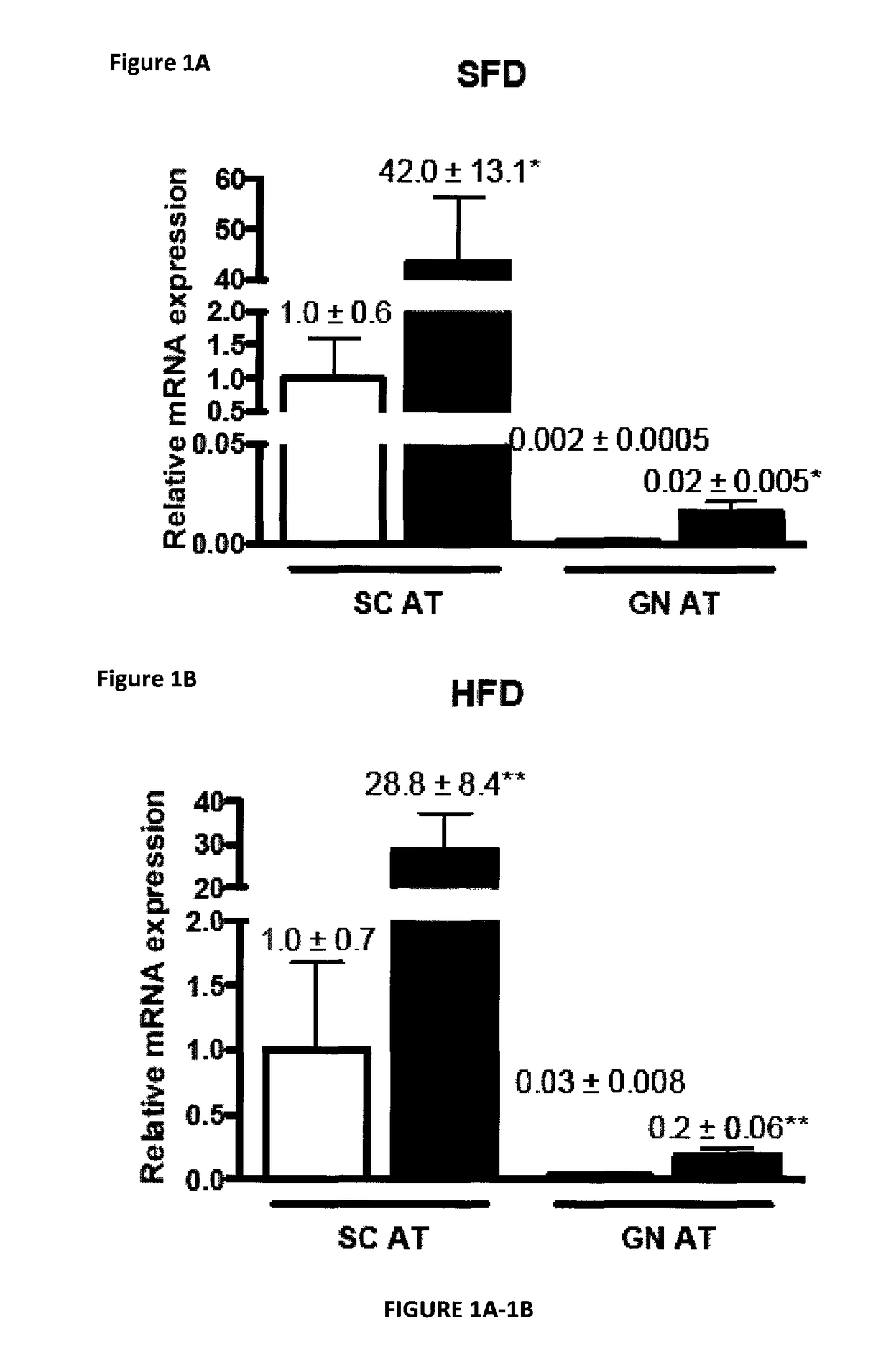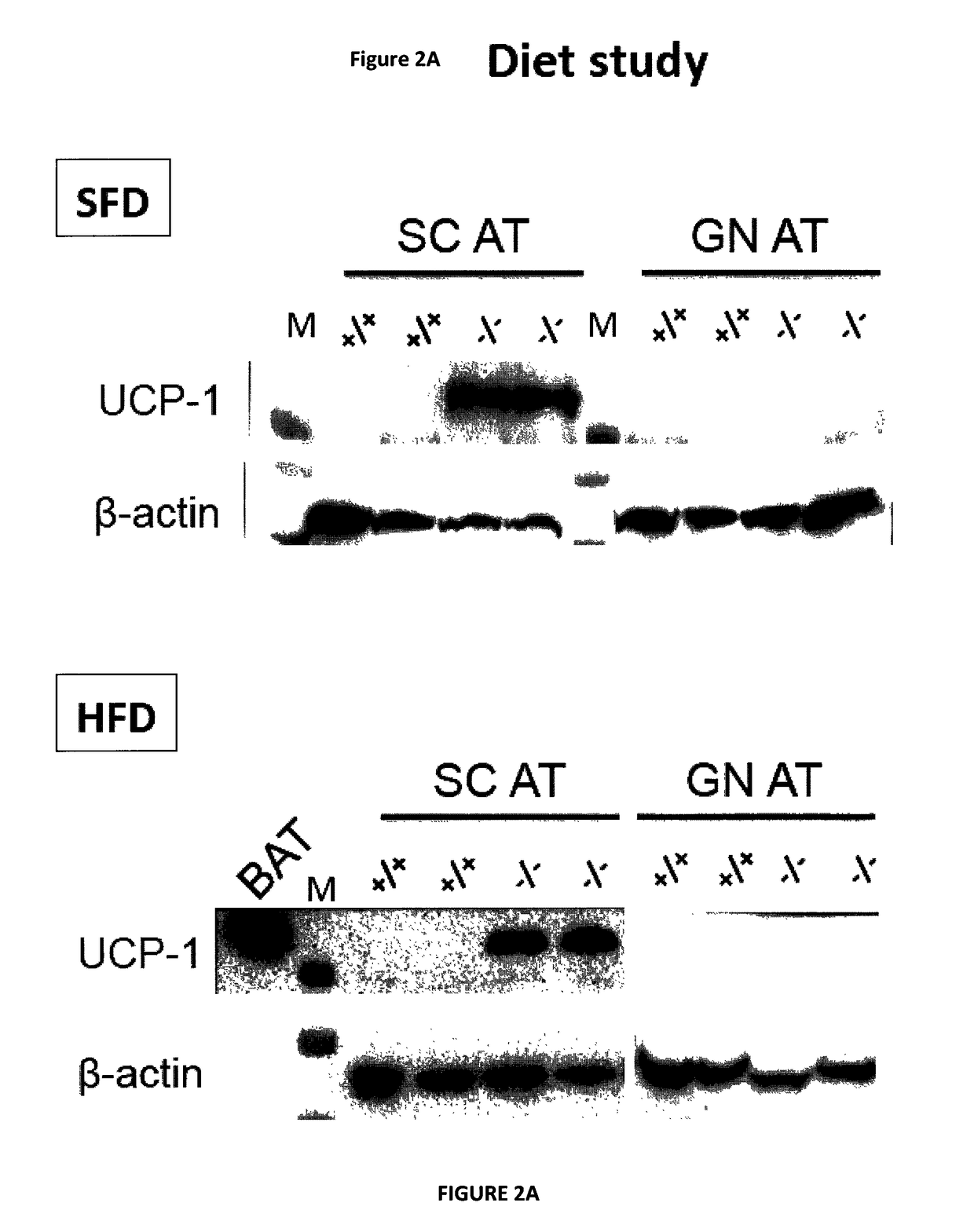Modulating adipose tissue and adipogenesis
a technology of adipogenesis and adipose tissue, which is applied in the field of obesity and related metabolic diseases, can solve the problems of inability to expand, inability to maintain in vitro, and lack of well-defined and effective metabolic and pharmacologic interventions, and achieve the effects of reducing the de novo adipogenesis or de novo fat development, and reducing the de novo adipogenesis
- Summary
- Abstract
- Description
- Claims
- Application Information
AI Technical Summary
Benefits of technology
Problems solved by technology
Method used
Image
Examples
example 1
[0146]1.1 Animals and Cells
[0147]Male athymic BALB / c NUDE mice were purchased from Charles River (Les Oncins, France). ADAMTS-5 wild-type (WT) and conditional knock-out (KO) mice were obtained as described elsewhere (Malfait A M, Ritchie J, Gil A S, Austin J S, Hartke J Qin W, et al. ADAMTS-5 deficient mice do not develop mechanical allodynia associated with osteoarthritis following medial meniscal destabilization. Osteoarthritis Cartilage. 2010; 18(4):572-80). Genotyping was performed using the forward 5′-TTTGAATTTGTCTTTGGAAGGCCTC-3′ and reverse 5′-TATCCCCGGATGAGTCAACACTGTC-3′ primer set. After a denaturation step at 94° C. for 2 min, isolated DNA was subjected to a polymerase chain reaction (PCR) consisting of denaturation at 94° C. for 30 sec, followed by 30 min of annealing at 63° C. and 1.5 min of elongation at 68° C. for 40 cycles.
[0148]3T3-F442A preadipocytes were obtained as described (Green H, Kehinde O. Spontaneous heritable changes leading to increased adipose conversion ...
example 2
[0159]2.1 In vitro Preadipocyte Differentiation and ADAMTS5 Knock-Down
[0160]Murine 3T3-F442A preadipocytes were routinely grown at subconfluence in basal medium (Dulbecco's modified Eagle's medium (DMEM; Invitrogen, Paisley, UK) supplemented with 10% bovine calf serum (BCS, iron supplemented; Hyclone, Logan, Utah, USA) and 1% PenStrep (Invitrogen)). Cells were passaged when preconfluent. To induce differentiation (Van Hul M, Bauters D, Himmelreich U, Kindt N, Noppen B, Vanhove M et al. Effect of gelatinase inhibition on adipogenesis and adipose tissue development. Clin Exp Pharmacol Physiol. 2012; 39(1):49-56), cells were seeded at a density of 30×103 cells cm-2 and grown to confluency (designated as ‘day 0’) in basal medium in an atmosphere of 95% humified air—5% CO2 at 37° C. After 2 days, cells were induced to differentiate for 48 h with induction medium (DMEM supplemented with 10% Fetal Bovine Serum (FBS), 17 nM insulin, 2 nM tri-iodothyronine (T3), 100 nM dexamethasone (DEX) an...
example 3
Effect of ADAMTS5 on Differentiation of Preadipocytes
[0172]During differentiation of 3T3-F442A preadipocytes into mature adipocytes, mRNA expression of ADAMTS-5 increased (FIG. 4A) and that of ADAMTS-4 decreased (FIG. 4B) with time. ADAMTS-5 gene silencing using shRNA was confirmed by markedly reduced expression of ADAMTS-5 (FIG. 4A), without an effect on ADAMTS-4 expression (FIG. 4B). Biglycan (FIG. 4C) or versican (FIG. 4D) expression levels were not affected by ADAMST-5 gene silencing. Expression of aggrecan and brevican was not detected during the differentiation period.
[0173]ADAMTS-5 knock-down was associated with significantly impaired differentiation (FIG. 4E), as shown by reduced Oil Red O staining and quantitative analysis (FIG. 4F). This was further supported by lower expression levels of the adipogenic markers aP2 and PPARγ(FIG. 4G-H), and higher expression of the preadipocyte marker Pref-1 (FIG. 41). Trypan Blue staining did not reveal an effect of gene silencing on cell...
PUM
| Property | Measurement | Unit |
|---|---|---|
| Fraction | aaaaa | aaaaa |
| Biological properties | aaaaa | aaaaa |
| Therapeutic | aaaaa | aaaaa |
Abstract
Description
Claims
Application Information
 Login to View More
Login to View More - R&D
- Intellectual Property
- Life Sciences
- Materials
- Tech Scout
- Unparalleled Data Quality
- Higher Quality Content
- 60% Fewer Hallucinations
Browse by: Latest US Patents, China's latest patents, Technical Efficacy Thesaurus, Application Domain, Technology Topic, Popular Technical Reports.
© 2025 PatSnap. All rights reserved.Legal|Privacy policy|Modern Slavery Act Transparency Statement|Sitemap|About US| Contact US: help@patsnap.com



